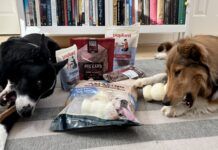[Updated August 9, 2018]
Without a doubt, the most common question I am asked is “What kind of food should I feed my dog?”
Unfortunately, the answer is not simple. I try to teach dog owners to recognize the hallmarks of good quality foods, buy a bunch of them to try, identify a few that really suit their dogs, and then to rotate between three or four of the best. I suggest that they give their dogs one food for 2-4 months, and then switch to another food, and then another. Ideally, the foods are made by a few different manufacturers, and contain completely different protein sources, too.
Variability in Our Dogs’ Diets
All “complete and balanced” pet foods, even the ones made of the best ingredients, contain a premixed vitamin/mineral supplement. This is intended to ensure that the finished products contain a minimum amount of the nutrients deemed vital for canine health. This is needed because many of the nutrients present in the food ingredients are destroyed in the manufacturing process, and because it’s difficult (if not impossible) to find food sources of some nutrients, especially the trace minerals.
Despite the inclusion of the vitamin/mineral premixes, however, laboratory analysis of the finished pet food may reveal a wide range of levels for all the nutrients contained in the finished products. The Association of American Feed Control Officials (AAFCO) provides guidelines for minimum levels for most nutrients, and maximum levels (for a few others). Within this basic framework, however, manufacturers have a lot of room to formulate their products to different levels, based on their own research, experience, and philosophies.
In fact, an interested dog owner can find quite a bit of variability in the nutrient levels in different pet foods – that is, if the maker will disclose this sort of minutiae. (The ones that won’t disclose the amount of any given nutrient in their formula aren’t worth dealing with, in my opinion.)
For example, the AAFCO nutrient profiles call for a minimum of 50 IU of vitamin E per kg of food, and a maximum of 1,000 IU/kg (based on dry matter, which excludes the moisture in the food from the calculations). Nature’s Variety reports that its “Prairie Brand Chicken and Rice Medley” contains 116 IU of vitamin E per kg of food (on a dry matter basis); Natura Pet Products reports that its “Innova” dry dog food contains 271 IU/kg of vitamin E.
Dogs Are What They Eat, Too
The point is, many of us have been conditioned to feed our dogs the same food, day in and day out. We are warned by food manufacturers and veterinarians alike that it is pointless and even possibly dangerous somehow to change a dog’s food. But a dog who eats the same diet every day can eventually become the living embodiment of the nutritional levels ever-present in his diet. To prevent nutrient toxicity, deficiency, or imbalance, the simple solution is to feed a variety of high-quality foods.
This just makes sense. If a company’s products are high in one nutrient, conceivably, after years of daily consumption of that food alone, a dog could develop problems associated with excessive levels of that nutrient. Years and years of feeding a food that is formulated to offer just slightly more than the minimum of another nutrient may result in a dog with a deficiency of that nutrient. Imbalances of nutrients that are best fed in certain proportions to each other (such as the Omega 3 and Omega 6 fatty acids) can also become entrenched in a dog’s body after years and years.
Smart Dog Food Switching
There are other reasons to change a dog’s food every few months or so. Switching from one source of protein to another occasionally can help prevent the development of food allergies or intolerances. It can also help prevent a dog from developing a stubborn preference for just one kind of food, which can be highly inconvenient.
When switching foods, spend a few days replacing the old food with the new in gradually larger proportions. This gives the dog’s digestive bacteria time to adjust to their new job, and should eliminate the gas or diarrhea that can sometimes accompany a sudden diet change.
Other than when you are switching from one food to another, it’s not a good idea to feed different foods at the same time. Your dog might enjoy a mix of half this and half that, but if he suddenly exhibits a digestive problem, it will be harder to track down the offending ingredients.
On a final note: Don’t hesitate to discontinue feeding any food your dog has a bad reaction to. No matter how much you trust its manufacturer, any product can suffer a dangerous manufacturing defect that could put your dog’s life at risk.






I feed my dog Royal canine for 4 days,I then give him to my mother for 4 days while I work. She gives him eukanuba. Is this a good idea or should we be feeding him the same? I do notice he is unsettled at times.. up and down
Royal Caninn has some controversial ingredients it’s almost the same with Eukanuba. I would recommend Ollie dog food or The Honest Kitchen.